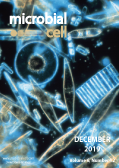Table of contents
Volume 6, Issue 12, pp. 527 - 546, December 2019
Cover: Assorted diatoms as seen through a microscope. These specimens were living between crystals of annual sea ice in McMurdo Sound, Antarctica. The tiny phytoplankton are encased within a silicate cell wall (image digitized from original 35mm Ektachrome slide; image by Gordon T. Taylor, Stony Brook University (USA) and provided by the U.S. National Oceanic and Atmospheric Administration Corps Collection; retrieved via Wikimedia Commons; the image was modified by MIC). The cover is published under the Creative Commons Attribution (CC BY) license.
Enlarge issue cover
Sulfur dioxide resistance in Saccharomyces cerevisiae: beyond SSU1
Estéfani García-Ríos and José Manuel Guillamón
News and thoughts |
page 527-530 | 10.15698/mic2019.12.699 | Full text | PDF |
Abstract
Sulfite resistance is an important oenological trait for wine yeasts because this compound is used during winemaking as a microbial inhibitor and antioxidant. The molecular mechanisms by which Saccharomyces cerevisiae responds and tolerates SO2 have been mainly focused on the sulfite efflux pump encoded by SSU1. Different chromosomal rearrangements in the regulatory region of this gene have been correlated with improved sulfite tolerance. However, other molecular factors must contribute to this trait because the SSU1 gene activity does not always fit with sulfite tolerance. An interesting approach to shed light onto this issue could be found by Lage et al. (2019). These authors have combined transcriptomic and genome-wide analysis to describe how the poorly characterized transcription factor Com2 controls, directly or indirectly, the expression of more than 80% of the genes activated by SO2. Additionally, large-scale phenotyping revealed the identification of 50 Com2-targets contributing to the protection against SO2. This information is very interesting for gaining knowledge regarding this important industrial trait.
Metabolic reprogramming of Salmonella infected macrophages and its modulation by iron availability and the mTOR pathway
Julia Telser, Chiara Volani, Richard Hilbe, Markus Seifert, Natascha Brigo, Giuseppe Paglia and Günter Weiss
Research Articles |
page 531-543 | 10.15698/mic2019.12.700 | Full text | PDF |
Abstract
Iron is an essential nutrient for immune cells and microbes, therefore the control of its homeostasis plays a decisive role for infections. Moreover, iron affects metabolic pathways by modulating the translational expression of the key tricarboxylic acid cycle (TCA) enzyme mitochondrial aconitase and the energy formation by mitochondria. Recent data provide evidence for metabolic re-programming of immune cells including macrophages during infection which is centrally controlled by mTOR. We herein studied the effects of iron perturbations on metabolic profiles in macrophages upon infection with the intracellular bacterium Salmonella enterica serovar Typhimurium and analysed for a link to the mTOR pathway. Infection of the murine macrophage cell line RAW264.7 with Salmonella resulted in the induction of mTOR activity, anaerobic glycolysis and inhibition of the TCA activity as reflected by reduced pyruvate and increased lactate levels. In contrast, iron supplementation to macrophages not only affected the mRNA expression of TCA and glycolytic enzymes but also resulted in metabolic reprogramming with increased pyruvate accumulation and reduced lactate levels apart from modulating the concentrations of several other metabolites. While mTOR slightly affected cellular iron homeostasis in infected macrophages, mTOR inhibition by rapamycin resulted in a significant growth promotion of bacteria. Importantly, iron further increased bacterial numbers in rapamycin treated macrophages, however, the metabolic profiles induced by iron in the presence or absence of mTOR activity differed in several aspects. Our data indicate, that iron not only serves as a bacterial nutrient but also acts as a metabolic modulator of the TCA cycle, partly reversing the Warburg effect and resulting in a pathogen friendly nutritional environment.
Tribal warfare: Commensal Neisseria kill pathogen Neisseria gonorrhoeae using its DNA
Magdalene So and Maria A. Rendón
Microreviews |
page 544-546 | 10.15698/mic2019.12.701 | Full text | PDF |
Abstract
It is now abundantly clear that our microbiota (commensals) are critical for many physiological and developmental processes. They have also been shown to inhibit pathogen colonization, through a variety of means including nutrient competition and secretion of microbicidal or biofilm-inhibiting proteins/peptides. Our recent study, Kim et al., (2019), adds a new dimension to the concept of commensal protection. It shows that commensal Neisseria kill the closely related pathogen N. gonorrhoeae through an unexpected mechanism, one that involves genetic competence, DNA methylation state and recombination. This microreview summarizes the report and discusses questions and lines of research arising from the study. Further investigation into this DNA-based killing mechanism will provide a better understanding of Neisseria biology and commensal-pathogen interactions on the mucosa, and identify strategies for preventing pathogenic Neisseria transmission.










